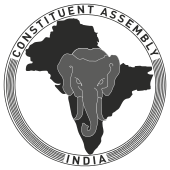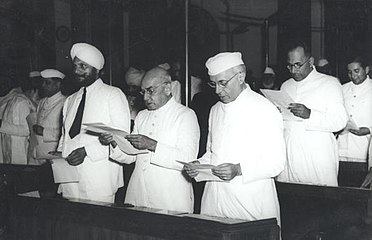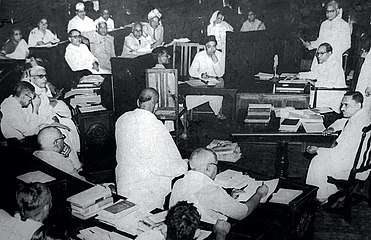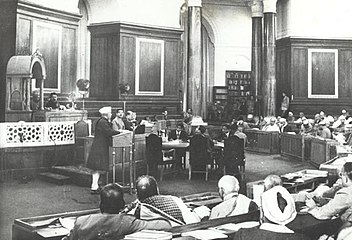Constituent Assembly of India
The Constituent Assembly of India was elected to write the Constitution of India. Following India's independence from British Government in 1947, its members served as the nation's first Parliament.
Constituent Assembly of India | |
|---|---|
 Seal of the Constituent Assembly. | |
| Type | |
| Type | |
| History | |
| Founded | 6 December 1946 |
| Disbanded | 24 January 1950 |
| Preceded by | Imperial Legislative Council |
| Succeeded by | Parliament of India |
| Leadership | |
Temporary Chairman | |
President | |
Vice President | |
Chairman of the Drafting Committee | B. R. Ambedkar, SCF |
| Structure | |
| Seats | 389 (Dec. 1946-June 1947) 299 (June 1947-Jan. 1950) |
 | |
Political groups | Others: 15 seats Princely States: 93 seats
|
| Elections | |
| Single Transferable Vote | |
| Meeting place | |
| House of Parliament, New Delhi | |
An idea for a Constituent Assembly was proposed in 1934 by M. N. Roy, a pioneer of the Communist movement in India and an advocate of radical democracy. It became an official demand of the Indian National Congress in 1935, C. Rajagopalachari voiced the demand for a Constituent Assembly on 15 November 1939 based on adult franchise, and was accepted by the British in August 1940.
On 8 August 1940, a statement was made by Viceroy Lord Linlithgow about the expansion of the Governor-General's Executive Council and the establishment of a War Advisory Council. This offer, known as the August Offer, included giving full weight to minority opinions and allowing Indians to draft their own constitution. Under the Cabinet Mission Plan of 1946, elections were held for the first time for the Constituent Assembly. The Constitution of India was drafted by the Constituent Assembly, and it was implemented under the Cabinet Mission Plan on 16 May 1946. The members of the Constituent Assembly were elected by the provincial assemblies by a single, transferable-vote system of proportional representation. The total membership of the Constituent Assembly was 389 of which 292 were representatives of the states, 93 represented the princely states and four were from the chief commissioner provinces of Delhi, Ajmer-Merwara, Coorg and British Baluchistan.
The elections for the 296 seats assigned to the British Indian provinces were completed by August 1946. Congress won 208 seats, and the Muslim League 73. After this election, the Muslim League refused to cooperate with the Congress, and the political situation deteriorated. Hindu-Muslim riots began, and the Muslim League demanded a separate constituent assembly for Muslims in India. On 3 June 1947 Lord Mountbatten, the last British Governor-General of India, announced his intention to scrap the Cabinet Mission Plan; this culminated in the Indian Independence Act 1947 and the separate nations of India and Pakistan. The Indian Independence Act was passed on 18 July 1947 and, although it was earlier declared that India would become independent in June 1948, this event led to independence on 15 August 1947. The Constituent Assembly met for the first time on 9 December 1946, reassembling on 14 August 1947 as a sovereign body and successor to the British parliament's authority in India. As a result of the partition, under the Mountbatten plan, a separate Constituent Assembly of Pakistan was established on 3 June 1947. The representatives of the areas incorporated into Pakistan ceased to be members of the Constituent Assembly of India. New elections were held for the West Punjab and East Bengal (which became part of Pakistan, although East Bengal later seceded to become Bangladesh); the membership of the Constituent Assembly was 299 after the reorganization, and it met on 31 December 1947. The constitution was drafted by 299 delegates from different caste ,region religion ,gender etc. These delegates sat over 114 days spread over 3 years (2 years 11 months and 17days to be precise) and discussed what the constitution should contain and what laws should be included. The Drafting Committee of the Constitution was chaired by Dr. B.R Ambedkar.
B. R. Ambedkar was a wise constitutional expert, he had studied the constitutions of about 60 countries. Ambedkar is recognised as the "Father of the Constitution of India".[1][2]
The constitution of India is the biggest constitution in the world as it includes laws from other countries' constitutions also.
Description of the constituent assembly
The Constituent Assembly of India, consisting of indirectly elected representatives, was established to draft a constitution for India (including the now-separate countries of Pakistan and Bangladesh). It existed for approx. three years, the first parliament of India after independence in 1947. The Assembly was not elected on the basis of universal adult suffrage, and Muslims and Sikhs received special representation as minorities. The Muslim League boycotted the Assembly after failing to prevent its creation. Although a large part of the Constituent Assembly was drawn from the Congress Party in a one-party environment, the Congress Party included a wide diversity of opinions—from conservative industrialists to radical Marxists, to Hindu revivalists.
The Assembly met for the first time in New Delhi on 9 December 1946, and its last session was held on 24 January 1950.[3] The hope of the Assembly was expressed by Jawaharlal Nehru:
The first task of this Assembly is to free India through a new constitution, to feed the starving people, and to clothe the naked masses, and to give every Indian the fullest opportunity to develop himself according to his capacity. This is certainly a great task. Look at India today. We, are sitting here and there in despair in many places, and unrest in many cities. The atmosphere is surcharged with these quarrels and feuds which are called communal disturbances, and unfortunately we sometimes cannot avoid them. But at present the greatest and most important question in India is how to solve the problem of the poor and the starving. Wherever we turn, we are confronted with this problem. If we cannot solve this problem soon, all our paper constitutions will become useless and purposeless. Keeping this aspect in view, who could suggest to us to postpone and wait?
Background and election
India was still under British rule when the Constituent Assembly was established following negotiations between Indian leaders and members of the 1946 Cabinet Mission to India from the United Kingdom. Provincial assembly elections were held in mid 1946. Constituent Assembly members were elected indirectly by members of the newly elected provincial assemblies, and initially included representatives for those provinces that formed part of Pakistan (some of which are now in Bangladesh). The Constituent Assembly had 299 representatives, including fifteen[4] women.
The Interim Government of India was formed on 2 September 1946 from the newly elected Constituent Assembly. The Congress Party held a large majority in the Assembly (69 percent of the seats), and the Muslim League held nearly all the seats reserved in the Assembly for Muslims. There were also members of smaller parties, such as the Scheduled Caste Federation, the Communist Party of India and the Unionist Party.
In June 1947 delegations from Sindh, East Bengal, Baluchistan, West Punjab and the North West Frontier Province withdrew to form the Constituent Assembly of Pakistan, meeting in Karachi. On 15 August 1947 the Dominion of India and Dominion of Pakistan became independent nations, and members of the Constituent Assembly who had not withdrawn to Karachi became India's Parliament. Twenty-eight members of the Muslim League joined the Indian Assembly, and 93 members were later nominated from the princely states; the Congress Party secured a majority of 82 percent.
Constitution and elections
At 11 am on 9 December 1946 the Assembly began its first session, with 207 members attending. By early 1947, representatives of the Muslim League and princely states joined, and the Assembly approved the draft constitution on 26 November 1949. On 26 January 1950 the constitution took effect (commemorated as Republic Day), and the Constituent Assembly became the Provisional Parliament of India (continuing until after the first elections under the new constitution in 1952).
Organization
Dr. Rajendra Prasad was elected as the president and Its vice-president was Harendra Coomar Mookerjee, a Christian from Bengal and former vice-chancellor of Calcutta University. Also chairing the assembly's Minorities Committee, Mookerjee was appointed governor of West Bengal after India became a republic. Jurist B. N. Rau was appointed constitutional adviser to the assembly; Rau prepared the original draft of the constitution, and was later appointed a judge in the Permanent Court of International Justice in The Hague.
The assembly's work had five stages:
- Committees presented reports on issues.
- B.N. Rau prepared an initial draft based on the reports and his research into the constitutions of other nations.
- The drafting committee, chaired by B. R. Ambedkar, presented a detailed draft constitution which was published for public discussion.
- The draft constitution was discussed, and amendments proposed and enacted.
- The constitution was adopted, with a committee of experts led by the Congress Party (known as the Congress Assembly Party) played a pivotal role.[5]
Time Line of Formation of "The Constitution of India"
- 6 December 1946: Formation of the Constitution Assembly. (in accordance with French practice.)
- 9 December 1946: The first meeting was held in the constitution hall (now the Central Hall of Parliament House). 1st person to address - J. B. Kripalani. Temporary president Appointed - Sachchidananda Sinha. (Demanding a separate state, the Muslim League boycotted the meeting.)
- 11 December 1946: President Appointed - Rajendra Prasad, vice-Chairman Harendra Coomar Mookerjee and constitutional legal adviser B. N. Rau (initially 389 members in total, which declined to 299 after partition. out of 389 - 292 were from govt. province, 4 from chief commissioner province and 93 from princely states)
- 13 December 1946: An 'Objective Resolution' was presented by Jawaharlal Nehru, laying down the underlying principles of the constitution. which later became the Preamble of the constitution.
- 22 January 1947: Objective resolution unanimously adopted.
- 22 July 1947: National flag adopted.
- 15 August 1947: Achieved independence. India Split into Dominion of India and Dominion of Pakistan.
- 29 August 1947: Drafting Committee appointed with Dr. B. R. Ambedkar as the Chairman.other 6 members of committee was : K.M.Munshi, Muhammed Saadulah, Alladi Krishnaswamy Iyer, Gopala Swami Ayyangar, N. Madhava Rao(He replaced B.L. Mitter who resigned due to ill-health), T. T. Krishnamachari(He replaced D.P. Khaitan who died in 1948),
- 16 July 1948: Along with Harendra Coomar Mookerjee V. T. Krishnamachari was also elected as second vice-president of Constituent Assembly.
- 26 November 1949: 'Constitution of India' passed and adopted by the assembly.
- 24 January 1950: Last meeting of Constituent Assembly. 'constitution of india' all signed and accepted. (with 395 Articles, 8 Schedules, 22 Parts)
- 26 January 1950: 'Constitution of India' came in to force. (It Took 2 Years, 11 Months, 18 Days - at a total expenditure of ₹6.4 million to finish)
- Ganesh Vasudev Mavalankar was the first speaker when meeting the assembly of Lok Sabha, after turning republic.
Committees of the Constituent Assembly
The Constituent Assembly appointed a total of 22 committees to deal with different tasks of constitution-making. Out of these, eight were major committees and the others were minor committees.
Major Committees
- Drafting Committee – B. R. Ambedkar
- Union Power Committee – Jawaharlal Nehru
- Union Constitution Committee – Jawaharlal Nehru
- Provincial Constitution Committee – Vallabhbhai Patel
- Advisory Committee on Fundamental Rights, Minorities and Tribal and Excluded Areas – Vallabhbhai Patel. This committee had the following subcommittees:
- Fundamental Rights Sub-Committee – J. B. Kripalani
- Minorities Sub-Committee – Harendra Coomar Mookerjee,
- North-East Frontier Tribal Areas and Assam Excluded & Partially Excluded Areas Sub-Committee – Gopinath Bordoloi
- Excluded and Partially Excluded Areas (Other than those in Assam) Sub-Committee – A V Thakkar
- Rules of Procedure Committee – Rajendra Prasad
- States Committee (Committee for Negotiating with States) – Jawaharlal Nehru
- Steering Committee – Rajendra Prasad
- National flag ad hoc committee – Rajendra Prasad
- Committee for the function of the consistution assembley - G V Mavlankar
- House committee - B Pattabhi Sitaramayya
- Language committee - Moturi Satyanarayana
- Order of business committee - K M Munshi
Criticism
The constitution has been, in more recent times, critiqued on the basis of the fact that the members of the Constituent Assembly were chosen not by universal suffrage, but rather, they were predominantly members of the Congress party. It has been argued that the Congress party aimed not to overthrow British power, but rather transfer its power into Indian hands. In his book The Constitution of India: Miracle, Surrender, Hope, Rajeev Dhavan has argued that the Indian people did not have much say in the making of the Constitution which was they had no choice but to accept. It has also been argued that the members of the Constituent Assembly were mostly Hindu men from dominant castes, which in the end embedded certain Hindu, dominant-caste and patriarchal prejudices in the Constitution.[6]
Prominent members
- B. R. Ambedkar, Polymath, Chairman of Drafting Committee, and first Law and Justice Minister of India
- B. N. Rau, Constitutional Advisor
- Jawaharlal Nehru, first Prime Minister of India
- Sardar Vallabhbhai Patel, first Deputy Prime Minister and Home Minister
- J.B. Kriplani, President of Indian National congress at the time of independence
- Maulana Abul Kalam Azad, Minister for Education
- Rajendra Prasad, President of Constituent Assembly
- C. Rajagopalachari, Governor-General of India
- Sarat Chandra Bose, Barrister and Indian independence activist
- Krishna Sinha, first Chief Minister, Bihar
- Binodanand Jha,
- Anugrah Narayan Sinha, Deputy Chief Minister and Finance Minister, Bihar
- Rafi Ahmed Kidwai
- Asaf Ali, Minister for Railways and Transport
- Syama Prasad Mookerjee, Industries Minister, President, Hindu Mahasabha
- Moturi Satyanarayana, Freedom Fighter
- Rajkumari Amrit Kaur, Health Minister
- Hansa Mehta, President, All India Women's Conference
- N. G. Ranga
- Deep Narayan Singh, Minister, Bihar
- Gopinath Bordoloi, Prime Minister of Assam
- Sir Syed Muhammad Saadulla, Assam
- P. Subbarayan
- Kailashnath Katju
- N. Gopalaswami Ayyangar
- T. T. Krishnamachari
- Rameshwar Prasad Sinha
- Durgabai Deshmukh
- K. M. Munshi
- Qaede Millath Mohammed Ismael Sahib, First President of IUML and Prominent Parliamentarian
- Krishana Ballabh Sahay
- Frank Anthony, Anglo-Indian representative
- Sarvepalli Radhakrishnan
- John Mathai, first railway minister of India
- Pratap Singh Kairon
- K. Kamaraj 3rd Chief Minister of Tamil Nadu
- Chidambaram Subramaniam
- Jaipal Singh Munda, Former Indian Hockey captain, and Tribal leader
- Hargovind Pant
- Maulana Hifzur Rahman Seoharwi
Members (by province/state)
Madras: Annie Mascarene, O. V. Alagesan, Mrs. Ammu Swaminathan, M. Ananthasayanam Ayyangar, Moturi Satyanarayana, Mrs. Dakshayani Velayudhan, Mrs. G. Durgabai, Kala Venkatarao, N. Gopalaswamy Ayyangar, D. Govinda Das, Revd. Jerome D'Souza, P. Kakkan, T.M. Kaliyannan Gounder, K. Kamaraj, V. C. Kesava Rao, T. T. Krishnamachari, Alladi Krishnaswamy Iyer L. Krishnaswami Bharathi, P. Kunhiraman, Mosalikanti Thirumala Rao, V. I. Munuswamy Pillai, M. A. Muthiah Chettiar, V. Nadimuthu Pillai, S. Nagappa, P. L. Narasimha Raju, B. Pattabhi Sitaramayya, C. Perumalswamy Reddy, T. Prakasam, S. H. Prater, Raja Swetachalapati Ramakrishna Renga Roa of Bobbili, R. K. Shanmukham Chetty, T. A. Ramalingam Chettiar, Ramnath Goenka, O. P. Ramaswamy Reddiar, N. G. Ranga, Neelam Sanjeeva Reddy, Sheik Galib Sahib, K. Santhanam, B. Shiva Rao, Kallur Subba Rao, U. Srinivasa Mallya, P. Subbarayan, C. Subramaniam, V Subramaniam, M. C. Veerabahu Pillai, P. M. Velayudapani, A. K. Menon, T. J. M. Wilson, Qaede Millath Mohamed Ismail Sahib, K. T. M. Ahmed Ibrahim, Mahboob Ali Baig Sahib Bahadur, B. Pocker Sahib Bahadur, Pattam Tanupillai
Bombay: Balchandra Maheshwar Gupte, Hansa Mehta, Hari Vinayak Pataskar, Dr. B. R. Ambedkar, Joseph Alban D'Souza, Kanayalal Nanabhai Desai, Keshavrao Marutirao Jedhe, Khandubhai Kasanji Desai, Bal Gangadhar Kher, M.R. Masani, K.M. Munshi, Narahar Vishnu Gadgil, S. Nijalingappa, S. K. Patil, Ramchandra Manohar Nalavade, R. R. Diwakar, Shankarrao Deo, G. V. Mavalankar, Vallabhbhai Patel, Abdul Kadar Mohammad Shaikh, A. A. Khan
West Bengal: Mono Mohan Das, Arun Chandra Guha, Lakshmi Kanta Maitra, Mihir Lal Chattopadhyay, Satis Chandra Samanta, Suresh Chandra Majumdar, Upendranath Barman, Prabhudayal Himatsingka, Basanta Kumar Das, Renuka Ray, H. C. Mookerjee, Surendra Mohan Ghose, Syama Prasad Mookerjee, Ari Bahadur Gurung, R. E. Platel, K. C. Neogy, Raghib Ahsan, Somnath Lahiri, Jasimuddin Ahmad, Naziruddin Ahmad, Abdul Hamid, Abdul Halim Ghuznavi
United Provinces: Maulana Hifzur Rahman Seoharwi, Ajit Prasad Jain, Algu Rai Shastri, Balkrishna Sharma, Banshi Dhar Misra, Bhagwan Din, Damodar Swarup Seth, Dayal Das Bhagat, Dharam Prakash, A. Dharam Dass, R. V. Dhulekar, Feroz Gandhi, Gopal Narain, Krishna Chandra Sharma, Govind Ballabh Pant, Govind Malviya, Har Govind Pant, Harihar Nath Shastri, Hriday Nath Kunzru, Jaspat Roy Kapoor, Jagannath Baksh Singh, Jawaharlal Nehru, Jogendra Singh[7], Jugal Kishore, Jwala Prasad Srivastava, B. V. Keskar, Kamala Chaudhry, Kamalapati Tripathi, J. B. Kripalani, Mahavir Tyagi, Khurshed Lal, Masurya Din, Mohan Lal Saksena, Padampat Singhania, Phool Singh, Paragi Lal, Purnima Banerjee, Purushottam Das Tandon, Hira Vallabha Tripathi, Ram Chandra Gupta, Shibban Lal Saxena, Satish Chandra, John Matthai, Sucheta Kripalani, Sunder Lall, Venkatesh Narayan Tiwari, Mohanlal Gautam, Vishwambhar Dayal Tripathi, Vishnu Sharan Dublish, Begum Aizaz Rasul, Hyder Hussain, Hasrat Mohani, Abul Kalam Azad, Muhammad Ismail Khan, Rafi Ahmad Kidwai, Z H Lari
East Punjab: Bakshi Tek Chand, Jairamdas Daulatram, Thakurdas Bhargava, Bikramlal Sondhi, Yashwant Rai, Ranbir Singh Hooda, Lala Achint Ram, Nand Lal, Baldev Singh, Giani Gurmukh Singh Musafir, Sardar Hukam Singh, Sardar Bhopinder Singh Mann, Sardar Rattan Singh Lohgarh Chaudhry Suraj Mal
Bihar: Amiyo Kumar Ghosh, Anugrah Narayan Sinha, Banarsi Prasad Jhunjhunwala, Bhagwat Prasad, Boniface Lakra, Brajeshwar Prasad, Chandika Ram, K. T. Shah, Devendra Nath Samanta, Dip Narain Sinha, Guptanath Singh, Jadubans Sahay, Jagat Narain Lal, Jagjivan Ram, Jaipal Singh Munda, Kameshwar Singh of Darbhanga, Kamaleshwari Prasad Yadav, Mahesh Prasad Sinha, Krishna Ballabh Sahay, Raghunandan Prasad, Rajendra Prasad, Rameshwar Prasad Sinha, Ramnarayan Singh, Sachchidananda Sinha, Sarangdhar Sinha, Satyanarayan Sinha, Binodanand Jha, P. K. Sen, Sri Krishna Sinha, Sri Narayan Mahtha, Syamanandan Mishra, Hussain Imam, Syed Jafar Imam, Latifur Rahman, Mohammad Tahir, Tajamul Hussain, Choudhry Abid Hussain. Hargovind Mishra
Central Provinces and Berar: Ambica Charan Shukla, Raghu Vira, Rajkumari Amrit Kaur, Bhagwantrao Mandloi, Brijlal Biyani, Thakur Cheedilal, Seth Govind Das, Hari Singh Gour, Hari Vishnu Kamath, Hemchandra Jagobaji Khandekar, Ratanlal Kishorilal Malviya, Ghanshyam Singh Gupta, Lakshman Shrawan Bhatkar, Panjabrao Deshmukh, Ravi Shankar Shukla, R. K. Sidhva, Dada Dharmadhikari, Frank Anthony, Kazi Syed Karimuddin, Ganpatrao Dani
Assam: Nibaran Chandra Laskar, Dharanidhar Basu-Matari, Gopinath Bardoloi, J. J. M. Nichols-Roy, Kuladhar Chaliha, Rohini Kumar Chaudhury, Muhammad Saadulla, Abdur Rouf
Orissa: Biswanath Das, Krishna Chandra Gajapati Narayana Dev, Harekrushna Mahatab, Laxminarayan Sahu Lokanath Mishra, Nandkishore Das, Rajkrishna Bose, Santanu Kumar Das, Yudhishir Mishra
Delhi: Deshbandhu Gupta
Ajmer-Merwara: Mukut Bihari Lal Bhargava
Coorg: C. M. Poonacha
Mysore: K.C. Reddy, T. Siddalingaiya, H. R. Guruv Reddy, S. V. Krishnamoorthy Rao, K. Hanumanthaiya, H. Siddaveerappa, T. Channiah
Jammu and Kashmir: Sheikh Muhammad Abdullah, Motiram Baigra, Mirza Mohammad Afzal Beg, Maulana Mohammad Sayeed Masoodi
Travancore-Cochin: Pattom A. Thanu Pillai, R. Sankar, P. T. Chacko, Panampilly Govinda Menon, Annie Mascarene, P.S. Nataraja Pillai, K.A. Mohamed, P.K.Lekshmanan
Madhya Bharat: Vinayak Sitaram Sarwate, Brijraj Narain, Gopikrishna Vijayavargiya, Ram Sahai, Kusum Kant Jain, Radhavallabh Vijayavargiya, Sitaram S. Jajoo
Saurashtra: Balwant Rai Gopalji Mehta, Jaisukhlal Hathi, Amritlal Vithaldas Thakkar, Chimanlal Chakubhai Shah, Samaldas Laxmidas Gandhi
Rajasthan: V. T. Krishnamachari, Hiralal Shastri, Sardar Singhjhi of Khetri, Jaswant Singhji, Raj Bhadur, Manikya Lal Varma, Gokul Lal Asava, Ramchandra Upadhyaya, Balwant Sinha Mehta, Dalel Singh, Jainarain Vyas
Patiala and East Punjab States Union: Ranjit Singh, Sochet Singh, Bhagwant Roy
Bombay States: Vinayakrao Balshankar Vaidya, B. N. Munavalli, Gokulbhai Daulatram Bhatt, Jivraj Narayan Mehta, Gopaldas A. Desai, Paranlal Thakurlal Munshi, B. H. Khardekar, Ratnappa Bharamappa Kumbhar B.N Datar
Orissa States: Lal Mohan Pati, N. Madhava Rau, Raj Kunwar, Sarangadhar Das, Yudhishthir Mishra
Central Provinces States: R. L. Malaviya, Kishorimohan Tripathi, Ramprasad Potai
United Provinces States: B. H. Zaidi, Krishna Singh
Madras States: V. Ramaiah, Ramakrishna Ranga Rao
Vindhya Pradesh: Avdesh Pratap Singh, Shambu Nath Shukla, Ram Sahai Tiwari, Mannulalji Dwidedi
Cooch Behar: Himmat Singh K. Maheshwari
Tripura and Manipur: Girja Shankar Guha
Bhopal: Lal Singh
Kutch: Bhawani Arjun Khimji
Himachal Pradesh: Yashwant Singh Parmar
Members who later withdrew after partition
East Bengal: Abdullah al Mahmood, Maulana Mohd Abdullah el Baqui, Abdul Hamid, Abdul Kasem Khan, Mohammad Akram Khan, A. Hamid, Azizuddin Ahmad, Muhammad Habibullah Bahar, Prem Hari Barma, Raj Kumar Chakraverty, Sris Chandra Chattopadhyaya, Abdul Matin Chaudhary, Murtaza Raza Choudhry, Hamidul Haq Chowdhury, Akhay Kumar Das, Dhirendra Nath Datta, Bhupendra Kumar Datta, Ebrahim Khan, Fazlul Huq, Fazlur Rahman, Ghayasuddin Pathan, Begum Shaista Suhrawardy Ikramullah, Liaquat Ali Khan, Mafizuddin Ahmad, Mahmud Hussain, Jnanendra Chandra Majumdar, A. M. Malik, Birat Chandra Mandal, Jogendra Nath Mandal, Mohammed Ali, Khwaja Nazimuddin, M.A.B.L. Nur Ahmed, Nurul Amin, Ishtiaq Hussain Qureshi, Sri Dhananjoy M.A. B.L. Roy, Maudi Bhakesh Chanda, B.L. Serajul Islam, Maulana Shabbir Ahmad Osmani, Shahabudin Khwaja, H.S. Suhrawardy, Harendra Kumar Sur, Tamizuddin Khan, Kawivi Kerwar Datta, Ghulam Mohammed
West Punjab: Mian Mumtaz Mohammad Khan Daultana, Ganga Saran, Zafarullah Khan, Iftikhar Hussain Khan, Mian Muhammad Iftikharuddin, Muhammad Ali Jinnah, Sheikh Karamat Ali, Nazir Ahmad Khan, Sardar Abdur Rab Nistar, Feroz Khan Noon, Omar Hayat Malik, Shah Nawaz Begum Jahan Ara, Sardar Shaukat Hyat Khan,
Northwest Frontier Province: Khan Abdul Ghaffar Khan, Sardar Bahadur Khan, Sardar Asad Ullah Jan Khan
Sindh: Abdus Sattar Abdur Rahman, Alhajj Muhammad Hashim Gazder, M.A. Khuhro
Balochistan: S. B. Nawab Mohammad Khan Jogezai
Gallery
 Jawaharlal Nehru and other members taking pledge during the midnight session of the Constituent Assembly of India held on 14 and 15 August 1947.
Jawaharlal Nehru and other members taking pledge during the midnight session of the Constituent Assembly of India held on 14 and 15 August 1947. Dr. Babasaheb Ambedkar, chairman, with other members of the Drafting Committee of the Constituent Assembly of India, on 29 August 1947.
Dr. Babasaheb Ambedkar, chairman, with other members of the Drafting Committee of the Constituent Assembly of India, on 29 August 1947. Dr. Babasaheb Ambedkar, chairman of the Drafting Committee, presenting the final draft of the Indian Constitution to Dr. Rajendra Prasad on 25 November 1949.
Dr. Babasaheb Ambedkar, chairman of the Drafting Committee, presenting the final draft of the Indian Constitution to Dr. Rajendra Prasad on 25 November 1949. Constituent Assembly of India.
Constituent Assembly of India. Jawaharlal Nehru addressing the constituent assembly in 1946.
Jawaharlal Nehru addressing the constituent assembly in 1946.
References
- Laxmikanth, M. INDIAN POLITY. McGraw-Hill Education. ISBN 9789352604883. Retrieved 6 April 2019 – via Google Books.
- "Constitution Day: A look at Dr BR Ambedkar's contribution towards Indian Constitution". India Today. Ist. Archived from the original on 31 March 2019. Retrieved 6 April 2019.
- M. Lakshmikanth, Indian Polity for Civil Services Examinations, 3rd ed., (New Delhi: Tata McGraw Hill Education Private Limited, 2011), p. 2.3
- Ravichandran, Priyadarshini (11 March 2016). "The women who helped draft our constitution". livemint.com/. Retrieved 2 December 2018.
- "Archived copy". Archived from the original on 11 May 2011. Retrieved 2014-05-12.CS1 maint: archived copy as title (link)
- Vanaik, Achin. "Does the Constitution deliver on its promises?". The Caravan. Retrieved 18 July 2019.
- http://rajbhawan.rajasthan.gov.in/content/rajbhawan/en/formergovernors/sardarshjogindersingh.html
- https://rajyasabha.nic.in/rsnew/constituent_assembly/constituent_assembly_mem.asp
Further reading
- Austin, Granville. The Indian Constitution, Cornerstone of a Nation. New Delhi: OUP India, 1999. ISBN 0-19-564959-1.
- Bipan Chandra, Mridula Mukherjee and Aditya Mukherjee. India Since Independence: Revised Edition. New Delhi: Penguin Books India, 2008.
- An Indian 10-episode TV series made by Rajya sabha TV called "SAMVIDHAN" described in detail how the Indian Constitution was made.